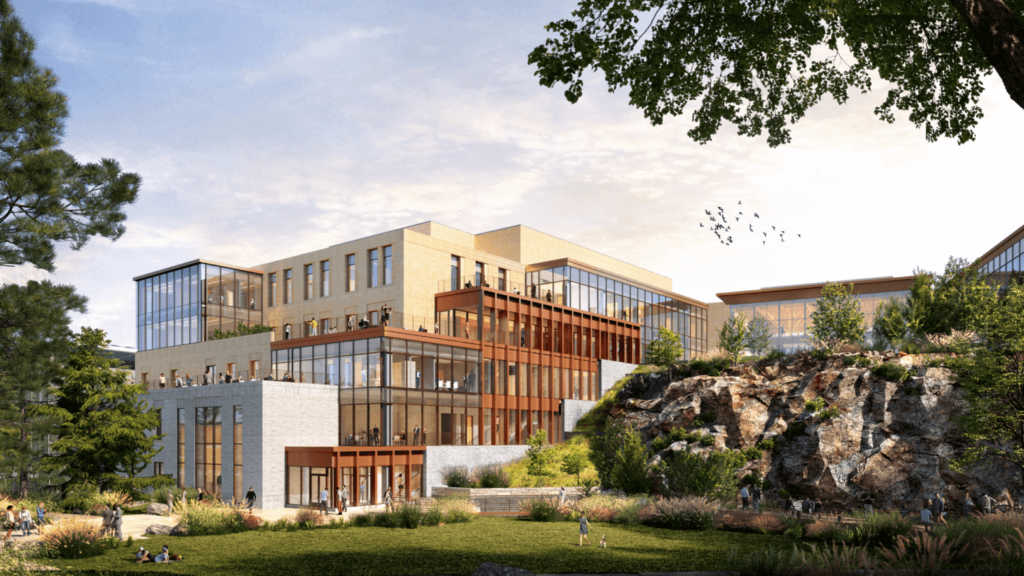NEWS
HGA News
04.04.2024
 Sustainably designed “Campus of the Future” to facilitate innovative biotechnology research
Sustainably designed “Campus of the Future” to facilitate innovative biotechnology research
Cell Signaling Technology (CST), a life science discovery technology company and leading provider of antibodies, kits, and services, has partnered with the acclaimed national interdisciplinary design firm HGA to develop a groundbreaking master plan and building design for a new research and innovation campus in Manchester-by-the-Sea, Mass. The plan sets a new industry benchmark for the development of a life sciences research facility by turning an environmentally depleted site into a climate-friendly laboratory campus that is reducing and eliminating fossil fuel to achieve net-zero emissions. Located on the site of a former gravel quarry, the final campus will revitalize the site’s natural ecosystem and engage employees and the surrounding community with innovative, green spaces and buildings.
“This is an architect’s dream—to marry our design thinking and holistic approach with CST’s project aspirations while transforming an abandoned quarry into a new campus for life sciences research,” said Samir Srouji, principal with HGA. “This is a distinctive site that requires an exceptional landscape and architectural response to restore it, while also reflecting CST’s culture, care for community and planet, and important work at the highest levels of research and development.”
CST’s sustainable “campus of the future” is located off Atwater Avenue, adjacent to Brady Industrial Park.
The master plan and building design will:
- Foster a sense of community and belonging for CST employees
- Reflect CST’s culture of environmental stewardship and social responsibility with a sustainable campus built for the company’s long-term future, including LEED, LEED Zero Carbon, and WELL certification targets
- Use the quarry cliff as a central, campus-organizing element to beautify the scarred grounds and engage employees and guests with their natural surroundings
- Create a Quarry Garden and an Upper Quad to provide an outdoor hub and resources for employees and visitors while connecting to a network of trails around the site
- Support CST’s net-zero emissions goal with building electrification and onsite renewables. Additionally, the heating, cooling, and hot water for the building will be sourced from geothermal energy
- Cultivate a thriving natural ecosystem with native plantings, resilient stormwater management to accommodate climate change, and an enhanced woodland environment
- Employ healthier materials for occupant well-being and reduce embodied carbon through selections such as mass timber for the lobby pavilion
- CST’s commitment to climate, health, and equity drove a design approach that integrated sustainability goals from the beginning.
“Achieving significant carbon reduction on a lab project of this scale requires collaboration and commitment from the owner and all design disciplines,” said Ariane Laxo, director of sustainability at HGA. “This project is setting a precedent in the science and technology market.”
CST’s Scientific Work Informs Design
Inspired by CST’s work in cell biology, HGA’s design concept for the campus references cell and membrane imaging throughout its organization of the buildings and connector network. The team is prioritizing local, low embodied carbon, and healthier materials. Proposed materials include a natural granite base with brick cladding, state-of-the-art curtain wall technology, including vacuum-insulated glazing (VIG), and mass timber structure for the multi-purpose lobby pavilion.
Phase 1 of the development will focus on research and innovation. To achieve this, HGA designed a highly flexible open lab environment with robust mechanical, electrical, and plumbing systems to allow the facility to adapt to new technology and instruments over time.
“The primary challenge is to design for unknown processes,” said Mark Allen, Life Sciences principal with HGA. “Our approach is to design the labs in a modular system with future capacity in the systems to anticipate renovations.”
Quarry Garden & Upper Quad
The dynamic composition of rock and plants at the abandoned quarry is the inspiration for the master plan, which celebrates the rugged qualities of the materials—reusing and up-cycling the granite left on site as a signature part of the new campus. A mass timber lobby pavilion will anchor the development and simultaneously serve as a campus “living room.” A primary circulation route will channel activity along a cloistered Upper Quad—the heart of the campus—and will cascade down the cliff to connect to the Quarry Garden, located at the base of the cliff. Sightlines will extend through the building, enabling natural light and an unobstructed view of both the surrounding landscape and CST scientists at the lab bench.
Supporting everyday life and employee well-being, the Quarry Garden and Upper Quad designed by Studio 2112 will serve as places for outdoor meetings and lunches, areas to walk, spaces for reflection, and links to the surrounding landscape, including public access to adjacent hiking trails. CST also owns the Manchester Athletic Club, which it will keep as an amenity for both the community and employees.
“Environmental stewardship is ingrained in our culture and values as a family-owned, private biotechnology firm. Our commitment to developing research tools that help extend the length and quality of human life also extends to revitalizing the planet and doing the right thing for future generations,” said Anthony J. Michetti, director of sustainability at Cell Signaling Technology. “Restoring ecological services, fossil fuel-free building design, and the selection of healthier materials are all vital foundations for the research we’ll conduct at the future campus.”
About Cell Signaling Technology
Cell Signaling Technology (CST) is a different kind of life science company—one founded, owned, and run by active research scientists, with the highest standards of product and service quality, technological innovation, and scientific rigor. Founded in 1999 and headquartered in Danvers, Massachusetts, USA, CST employs over 600 people worldwide. We consistently provide fellow scientists around the globe with best-in-class products and services to fuel their quests for discovery. CST is a company of caring people driven by a devotion to facilitating good science—a company committed to doing the right thing for our customers, our communities, and our planet. cellsignal.com
About HGA
HGA is a national interdisciplinary design firm committed to making a positive, lasting impact for our clients and communities through research-based, holistic solutions. We believe that great design requires a sense of curiosity—forming deep insight into our clients, their contexts, and the human condition. We are a collective of over 1,000 architects, engineers, interior designers, planners, researchers, and strategists. Our practice spans multiple markets, including science and technology, corporate, cultural, education, local and federal government, and healthcare. Visit HGA.com or follow on LinkedIn, Instagram, and Facebook.
HGA Media Contact
Michelle Nelsen, Public Relations Director
Phone: 612.758.4407
email: mnelsen@hga.com
The full content of this article is only available to paid subscribers. If you are an active subscriber, please log in. To subscribe, please click here: SUBSCRIBE




